
Browse an alphabetical list of photographs. These historical images portray people, places, and events before, during, and after World War II and the Holocaust.
<< Previous | Displaying results 2051-2100 of 2641 for "Photo" | Next >>
In Hitler's presence, Romanian ruler Ion Antonescu signs the Three-Power Agreement. Berlin, Germany, November 23, 1940.
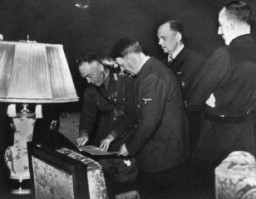
Horia Sima, leader of the Iron Guard and deputy prime minister of the Romanian government in 1940. Bucharest, Romania, 1940. In this image, Horia Sima salutes his supporters during a ceremony commemorating the deaths of Ion Mota and Vasile Marin, Iron Guardsmen who were killed in the Spanish Civil War.
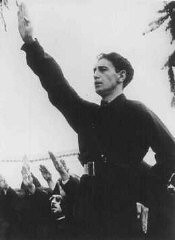

German police round up Jews in the Jewish quarter of Amsterdam, blockaded following anti-Nazi violence. Amsterdam, the Netherlands, February 22, 1941.
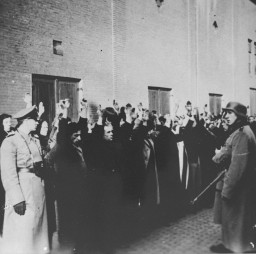
Austrian police round up Romani (Gypsy) families from Vienna for deportation to Poland. Austria, September-December 1939.
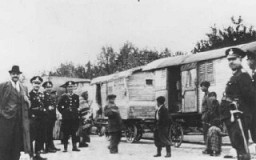
After the first roundup in Paris, French police escort foreign Jewish men from the Japy school to deportation trains at the Austerlitz station. Paris, France, May 14, 1941.
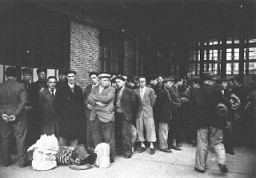
Jews captured during the Warsaw ghetto uprising are marched past the St. Zofia hospital down Nowolipie Street towards the Umschlagplatz for deportation.
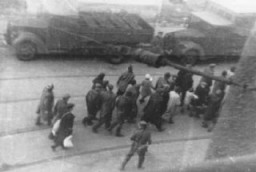
Jews rounded up during the Warsaw ghetto uprising are forced to march to the assembly point for deportation. Warsaw, Poland, April or May 1943.
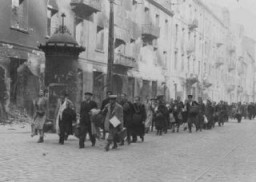
Lithuanian militiamen in Kovno round up Jewish women. Kovno, Lithuania, June-July, 1941.
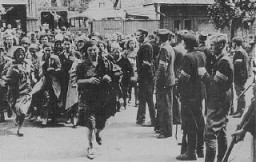
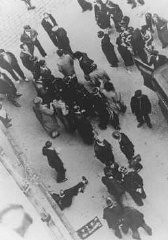
Roundup of the Jews of Lubny, shortly before they were massacred by Einsatzgruppe detachments. This photo, originally in color, was part of a series taken by a German military photographer. Copies from this collection were later used as evidence in war crimes trials. Lubny, Soviet Union, October 16, 1941.
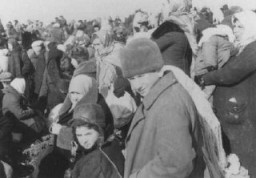
Rufus Jones (seated) and Clarence Pickett were chairman and executive secretary of the American Friends Service Committee (AFSC), respectively. They are pictured here at a Quaker meeting in Philadelphia. The AFSC assisted Jewish and Christian European refugees. Philadelphia, United States, January 22, 1943.
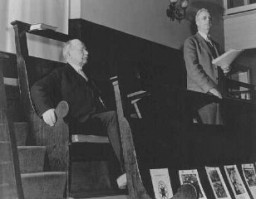
Ruins in Oradour-sur-Glane, France. The town was destroyed by the SS on June 10, 1944. Photograph taken in September 1944.

Ruins of a building in the Kovno ghetto gutted when the Germans attempted to force Jews out of hiding during the final destruction of the ghetto. Photographed by George Kadish. Kovno, Lithuania, August 1944.
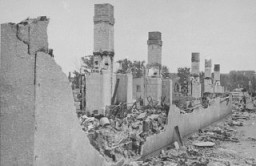
View of the entrance to a marketplace reduced to rubble as a result of a German aerial attack. Warsaw, Poland, September 1939.
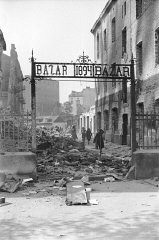
A Polish town lies in ruins following the German invasion of Poland, which began on September 1, 1939.
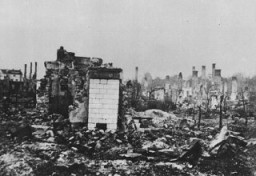
A Polish town in ruins after six years of war and German occupation. Poland, 1945.
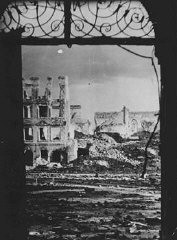
A bombed out home in Warsaw, the besieged capital of Poland. Only a chimney and a stove remain relatively intact. Photograph taken by Julien Bryan (1899-1974), a documentary filmmaker who filmed and photographed the everyday life and culture of individuals and communities in a variety of countries around the globe. In Warsaw following the German invasion of Poland, Bryan filmed and photographed the German bombardment and its impact on the Polish citizenry. He was able to leave during a brief truce that was…
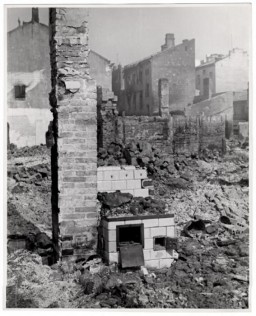
Herzog Rudolfstrasse synagogue after it was destroyed during Kristallnacht (the "Night of Broken Glass"). Munich, Germany, November 1938.
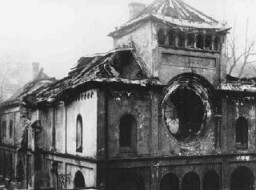
The ruins of Oradour-sur-Glane, destroyed by the SS on June 10, 1944. Oradour-sur-Glane, France, photograph taken in September 1944.

View of the ruins of the central barracks (Boelke Kaserne) in the Nordhausen concentration camp. This photograph was taken after liberation. Germany, April 1945.
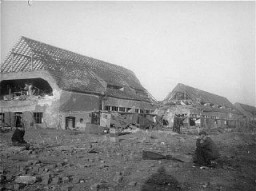
View of the old synagogue in Aachen after its destruction on Kristallnacht. Aachen, Germany, photo taken ca. November 10, 1938.
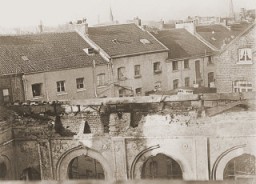
View of the old synagogue in Aachen after its destruction on Kristallnacht. Aachen, Germany, photo taken ca. November 10, 1938.
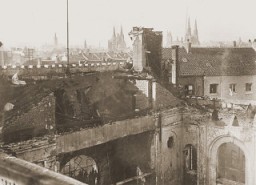
Ruins of the Warsaw ghetto after the Warsaw ghetto uprising. Poland, May 1943.
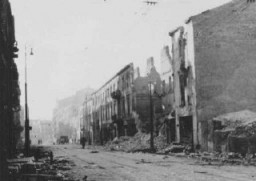
A view of the wall surrounding the ruins of the Warsaw ghetto in German-occupied Poland a few months after the ghetto's destruction. Photograph taken ca. June-October 1943.

Russian-born Jewish artist Marc Chagall with his daughter, Ida. The Nazis declared Chagall's work "degenerate." After the fall of France, where he had been living, Chagall fled to the United States. United States, 1942.
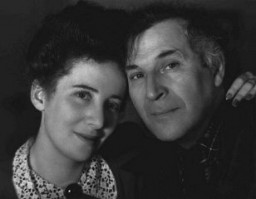
The most notorious of the 189 known interrogation centers in Cambodia was S-21, housed in a former school and now called Tuol Sleng for the hill on which it stands. Between 14,000 and 17,000 prisoners were detained there, often in primitive brick cells built in former classrooms. Only 12 prisoners are believed to have survived.
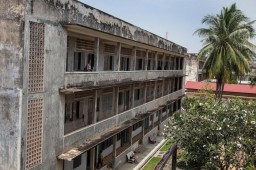
An SA member instructs others where to post anti-Jewish boycott signs on a commercial street in Germany. A German civilian wearing a Nazi armband holds a sheaf of anti-Jewish boycott signs, while SA members paste them on a Jewish-owned business. Most of the signs read, "Germans defend yourselves against Jewish atrocity propaganda/Buy only at German stores." Germany, ca. April 1, 1933.
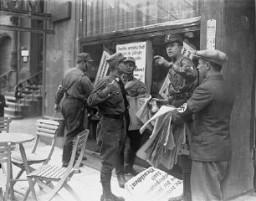
Uniformed members of the SA parade down a city street in Duisburg during a Nazi rally, circa 1928.
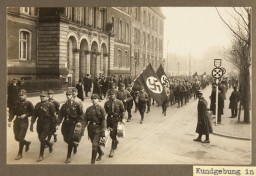
During the anti-Jewish boycott, SA men carry banners which read "Germans! Defend Yourselves! Do Not Buy From Jews!" Berlin, Germany, March or April 1933.
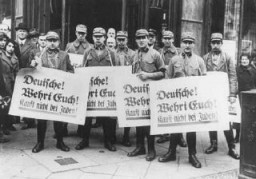
Battalions of Nazi street fighters salute Adolf Hitler during an SA parade through Dortmund. Germany, 1933.
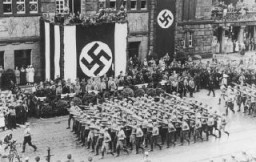
Salek Liwer (center) with friends at a Dror Zionist youth movement seminar in the Bad Gastein displaced persons camp in Austria, 1946.
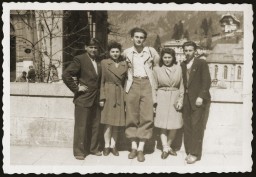
Members of the Saleschutz family do laundry in the yard of their home. Kolbuszowa, Poland, 1934.

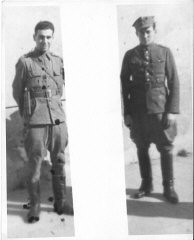
Samples of the Nuremberg Race Laws (the Reich Citizenship Law and the Law for the Protection of German Blood and Honor). Germany, September 15, 1935.
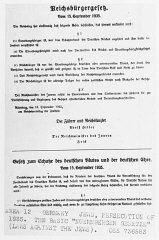
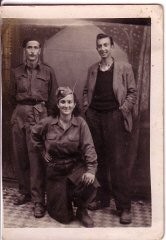
Forced laborers inside barracks soon after the liberation of Kaufering IV, part of a network of Dachau subcamps. Landsberg-Kaufering, Germany, 1945.
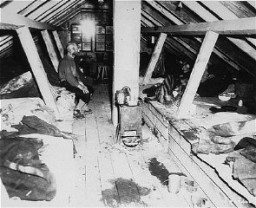
German spectators at a Nazi rally stand alongside a monument decorated with Nazi flags and a swastika emblem in Berlin. Germany, 1937.
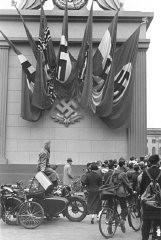
Jews carrying bundles of possessions who were forced to gather at an assembly point before their deportation from the Kovno ghetto, probably to Estonia. Kovno, Lithuania, October 1943. This photograph was taken by George Kadish.
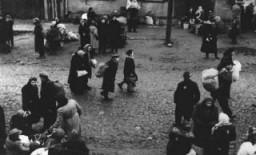
An American anti-aircraft gun, towed by a truck camouflaged with foliage, moves into position in the Hürtgen Forest to provide fire support against ground targets. November 6, 1944. US Army Signal Corps photograph taken by C A Corrado.
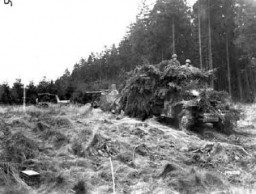
Sign used during the anti-Jewish boycott: "Help liberate Germany from Jewish capital. Don't buy in Jewish stores." Germany, 1933. (Source record ID: X89-204/08)
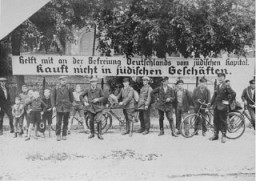
A soldier prepares to bed down for the night in a Belgian forest during the Battle of the Bulge. December 21, 1944. US Army Signal Corps photograph taken by J Malan Heslop.
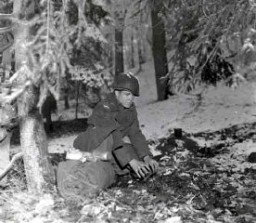
Stretcher bearers carry a wounded soldier during the Battle of the Somme in World War I. France, September 1916. IWM (Q 1332)
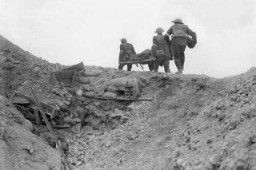
Construction of Oskar Schindler's armaments factory in Bruennlitz. Czechoslovakia, October 1944.
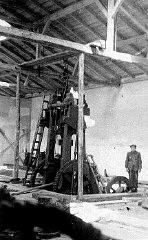
This clandestine photograph taken by George Kadish captures a scene during the deportation of Jews from the Kovno ghetto in German-occupied Lithuania in 1942.
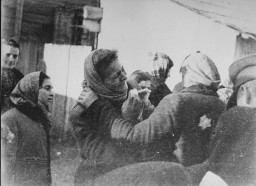
Scene during the Evian Conference on Jewish refugees. On the far right are two of the US delegates: Myron Taylor and James McDonald of the President's Advisory Committee on Political Refugees. Evian-les-Bains, France, July 1938.

On August 1, 1936, Hitler opened the 11th Summer Olympic Games. Inaugurating a new Olympic ritual, a lone runner arrived bearing a torch carried by relay from the site of the ancient Games in Olympia, Greece. This photograph shows an Olympic torch bearer running through Berlin, passing by the Brandenburg Gate, shortly before the opening ceremony. Berlin, Germany, July-August 1936.

US sailors struggle to contain damage from Kamikaze attacks during the US invasion of Okinawa, the largest of the Ryukyu Islands (the islands closest to the Japanese home islands). May 11, 1945.
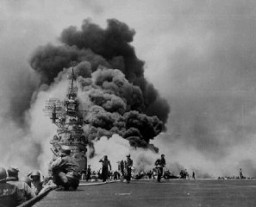
German soldiers direct artillery against a pocket of resistance during the Warsaw ghetto uprising. Warsaw, Poland, April 19-May 16, 1943.

This photo originates from a film produced by the Reich Propaganda Ministry. It shows two doctors in a ward in an unidentified asylum. The existence of the patients in the ward is described as "life only as a burden." Such propaganda images were intended to develop public sympathy for the Euthanasia Program.
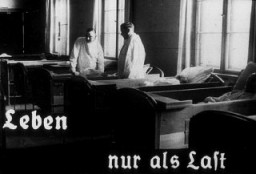
We would like to thank Crown Family Philanthropies, Abe and Ida Cooper Foundation, the Claims Conference, EVZ, and BMF for supporting the ongoing work to create content and resources for the Holocaust Encyclopedia. View the list of donor acknowledgement.